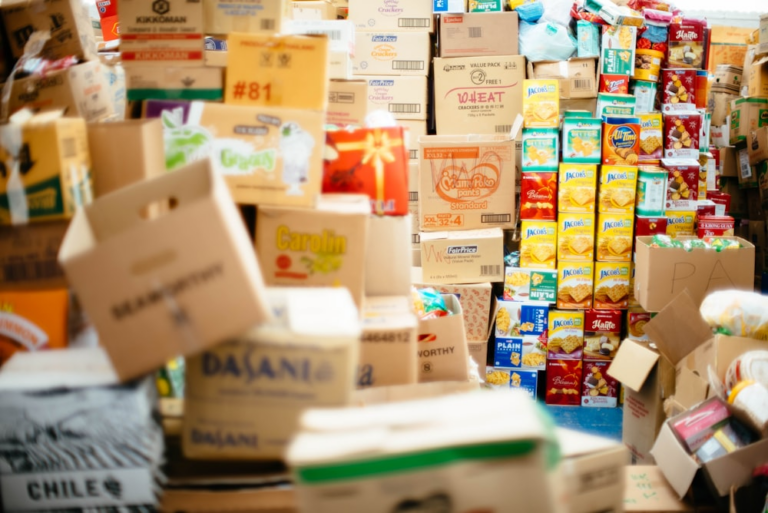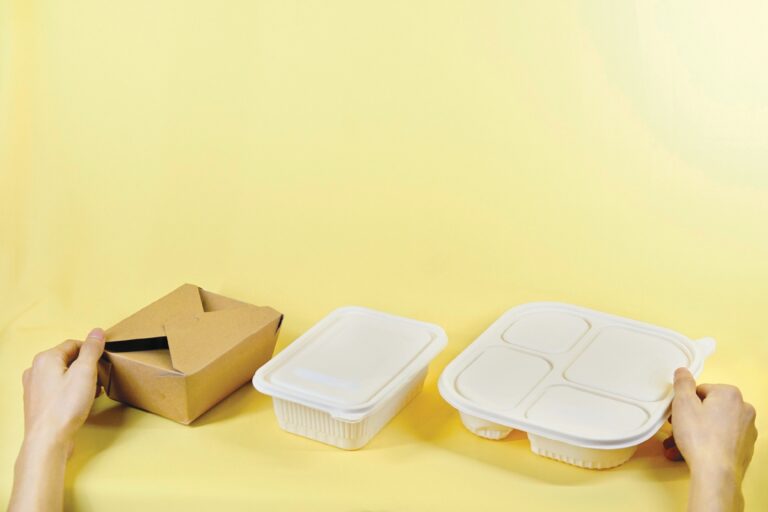China expects to import over 40 trillion US dollars of goods and services in the next 15 years, which means that a lot of foreign brands are capitalizing on this opportunity to enter the Chinese market.
But with the growing pressure placed upon companies to create packages that attract consumers and differentiates them from competitors, some brands may feel lost when faced with the challenge of packaging, especially in Asia. Discover the keys to creating the best packaging design in China when localizing your brand and respecting the environment.
Packaging design in China, a business’s primary selling tool
The power of packaging in China: boost your sales
We have all heard about the ‘Moments of Truth’ theorized by Jan Carlzon in 1985, defining the stages when customers interact with products during the purchasing process The critical thing to remember is that every time a consumer comes into contact with a brand it is an opportunity to pursuade.
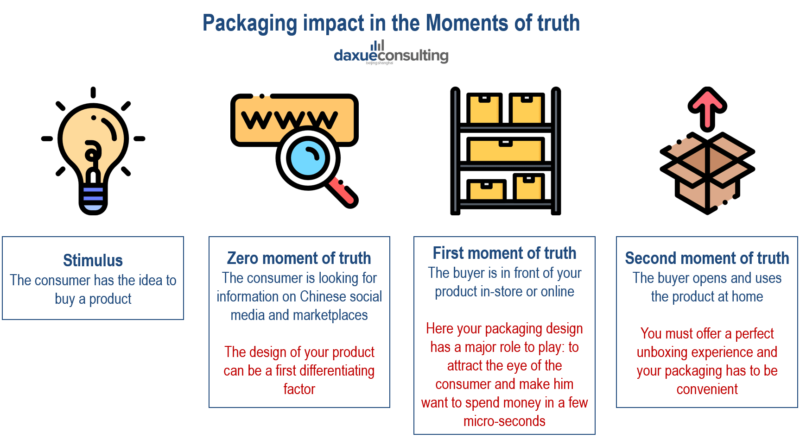
And this is here that we understand the importance of packaging design in China. It is a key element of the first moment of truth when the consumer looks at your product (in-store or online). When you consider that there are about 20,000 products that are before the eyes of a typical consumer during his 30-minute shopping in a grocery store, then it is obvious that packaging is a crucial element of your strategy.
Product packaging in China is the most tangible representation of a brand for customers. Indeed, packaging design has less than 3 seconds to grab the attention of a consumer. Those 3 seconds are extremely important because more than 70% of purchasing decisions are made at the shelf (in-store or online).
Additionally, the 2018 HKTDC Research survey unveiled that, compared to 2013, the importance attached to packaging design (for food products) has increased significantly in China. On the other hand, the attention paid to raw materials used and the price has declined.
Why it is necessary to adapt your packaging design in China
One would think that because Chinese consumers love foreign products,there is no need to adapt your packaging to the market. Why adopt a more Chinese identity when consumers love the look of European or American products?
On the one hand, it is true that Chinese consumers see foreign products as higher quality. In fashion, sportswear, cosmetics, jewelry, and baby care products for examples, the Chinese more often trust Western brands than local ones.
However, when it comes to the design-related topic, China is still regarded as a unique market, which is even different from other Asian countries. Thus, colors, shapes, materials, and designs are culturally specific:
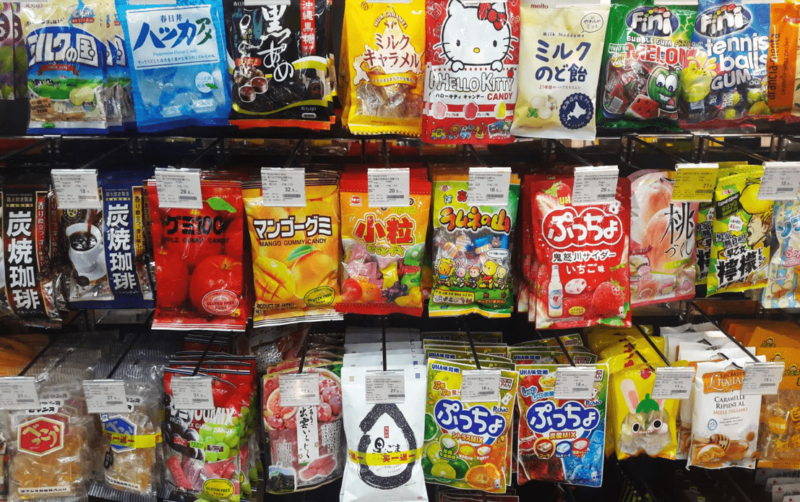
In addition, it should be noted that even though young urban consumers are increasingly worldly and better at English, most Chinese do not speak proficient English (only 10 million people speak fluent English) and therefore an import product needs a Chinese name, a Chinese brand signature and all communication media translated into Chinese. An essential first step when thinking about your packaging in China.
Thus, getting the right unboxing experience can have a serious impact on your sales in China, that is why you need to understand the packaging preferences of Chinese consumers in 2019.
How to adapt your product packaging in China to the preferences of Chinese consumers
Colorful packaging design in China, yes, but beware of Chinese meanings!
Colors increase brand recognition by 80% and influence 65% to 85% of product purchasing. In China, it first helps people to identify the target of the product. For food packaging in China, it can be a good indicator of the ingredients of the product (e.g., sugar, healthy ingredients, fruits…). Also, because of the Chinese market’s food and beverage counterfeit problem, packaging color consistency helps the consumer know that the product is real.
Choosing the right color palette for your packaging in China is, therefore, a big challenge. Here is a short guide on what you need to know about colors in China:
In traditional Chinese culture, red is a highly symbolic color, reminiscent of luck and prosperity (which is why it is everywhere during Chinese festivities such as Chinese New Year). Gold is seen as the royal color.
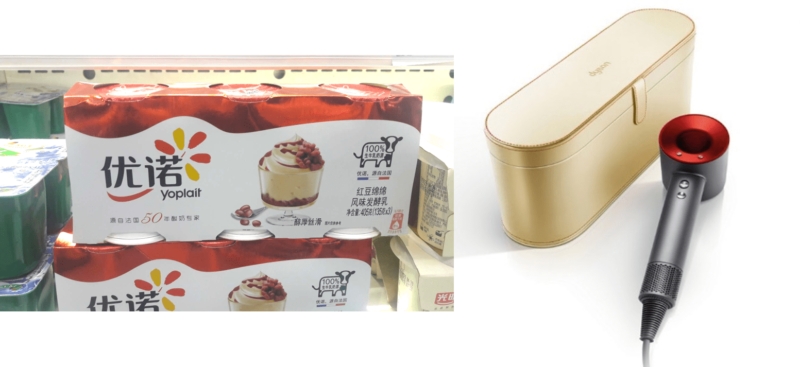
Blue is a fairly neutral color, often reminiscent of masculinity.
Green is often seen as a negative color because it is associated with infidelity and anger, even if we see more and more vegan or healthy brands opting for green packaging.
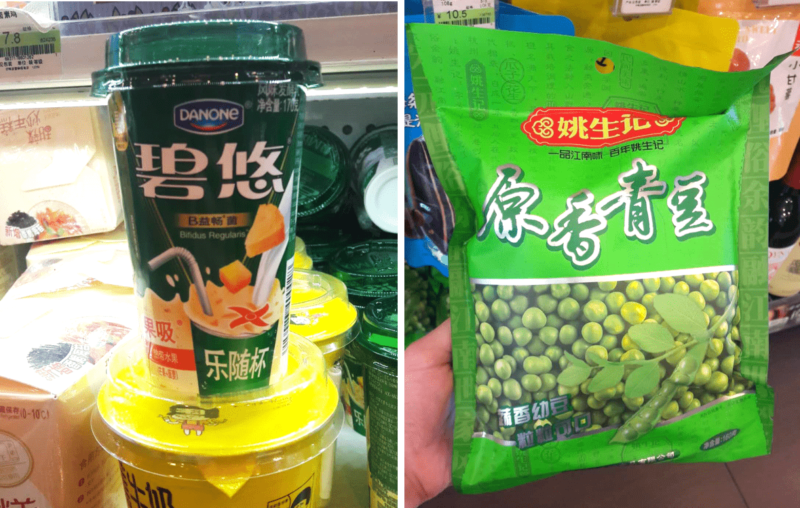
Finally, as far as black and white are concerned, Chinese standards are quite different. White is seen as the color of purity, simplicity but is also the color of the funeral. Brands must, therefore, be vigilant. As for black, it is a common and neutral color used in everyday life. Note that in the food and beverage shelves, there is almost no black packaging.
According to Labbrand, Chinese consumers generally find appealing bright and flashy colors for food and beverage items and tend to prefer white and pastel colors for cosmetics and household products.
Moreover, the most essential step is to apply the right color for the right product. It is not enough to have red and gold packaging to attract Chinese consumers.
Logo and brand names: finding the right fit
Beyond the colors, your packaging design in China must include your brand name and logo so that it is easily recognizable. Thus, the adaptation of your name must be done in Chinese. This will help you convey your message more efficiently and activate word of mouth (challenging to recommend a brand that you can’t even say or write).
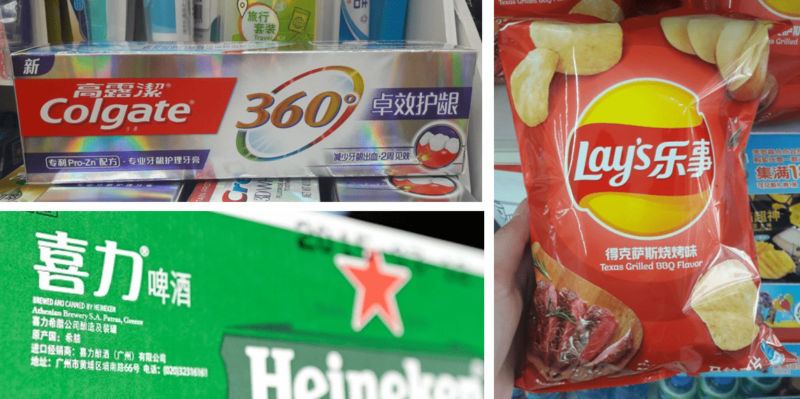
As you can see above, some brands have decided to convey a stronger message in Chinese using characters. This is the case of Heineken which has chosen, as a Chinese brand name, 喜力(xǐ lì). 喜(xǐ) means ‘‘like’’ and 力(lì) means ‘‘power’’. In Chinese, Lay’s is sold as 乐事 (lè shì) which means happy things. Colgate has also chosen a Chinese name to emphasize on the quality, 高露洁 (gāo lù jié) meaning ‘‘high reveal clean’’.
This will also help you avoid negative connotations of your name in Chinese. For example, the Bing search engine has not been very successful in China, particularly because of its similarity to the Chinese pronunciation of “sick” (bìng 病).
Packaging material: what are the 2019 trends in the packaging industry in China?
According to the latest report named Latest Trends and Key Issues in the Chinese Retail Packaging Market, China sees a growing trend in the use of flexible, glass, rigid plastic, rigid metal, and paper & board packaging materials.
Among these trends, the increasing demand for lighter and cheaper packaging makes rigid plastic the most used and preferred pack type for FMCG products. In 2018, rigid plastic and flexible packaging were among the major share gainers with share growth of 3% and 1% respectively.
However, the packaging industry in China is in a state of transition. Indeed, the Chinese are increasingly turning to a green lifestyle and are trying to buy more environmentally friendly packaging. For example, some brands have started to use recyclable materials for their products, which has an impact on sales despite a higher production price.
Finally, food packaging in China sees great innovations. Some materials are chosen for how they benefit the products, such as antimicrobial properties and mechanical strength.
Creating packaging design in China, steps, and tips
One of the most difficult things to do when you want to localize your brand in Asia and work on new packaging design in China is to find the right partners. Daxue Consulting provides you with the best advice to work with the right packaging manufacturers in China, to make green packaging in China your first choice and ensure the best results for your product.
Dealing with packaging manufacturers in China: two leading solutions
- Custom designed product packaging method (OEM)
This method consists of giving your packaging manufacturer in China a very specific request.
This requires that you have previously designed your packaging. If you have a design department, then this method is definitely for you. In China, suppliers are used to handling these requests. However, if you do not have a specific department for design in your company, you will probably need to call upon a professional to choose the right material, thickness, dimensions, Pantone colors, etc.
The disadvantages of this method are the price, the execution time (in China, count between two and four months), and the quality. Indeed, when manufacturing a product with special requests, quality problems are frequent.
- Using a factory designed product packaging method (ODM)
This second method consists in choosing a packaging from a selection proposed by your packaging manufacturer in China. An ODM factory will offer you packaging according to the functions of your product and your expectations.
Most suppliers in China have five to twenty different standard packaging models for their customer’s selection. You will not be able to customize the dimensions, materials or design on every product but don’t worry, you can still choose the standard or Pantone colors, prints, and sizes of captions, pictures, logo, etc.
The main benefit of ODM is that you will save a lot of time (in China, count around one month). Also, it is much cheaper than OEM.
However, it may be unpleasant to allow the supplier to take credit for the design of the products, but if you choose the right packaging manufacturer in China by requesting an audit report for example, then there is nothing to worry about.
Top 3 best packaging manufacturers in China: make green packaging in China your first choice!
- GPA Global (plastic packaging)
Based in Shenzen, GPA Global is a custom packaging manufacturer in China, focusing on the packaging for retail and display. The company is highly attractive because of its development of green packaging in China.Rather than using biodegradable and recycled plastics, they use natural materials like sugarcane waste, molded pulp, wood free paper, and water-based glues.
They have also developed their own material called Greenblister, which is a mix of recycled (and recyclable) paperboard and plastic.
‘‘As a company built on sustainable values and methods, we promise not only a fantastic service but an eco-friendly end product.’’
Some of their clients are Louboutin, Johnnie Walker, JBL, Bose, etc.
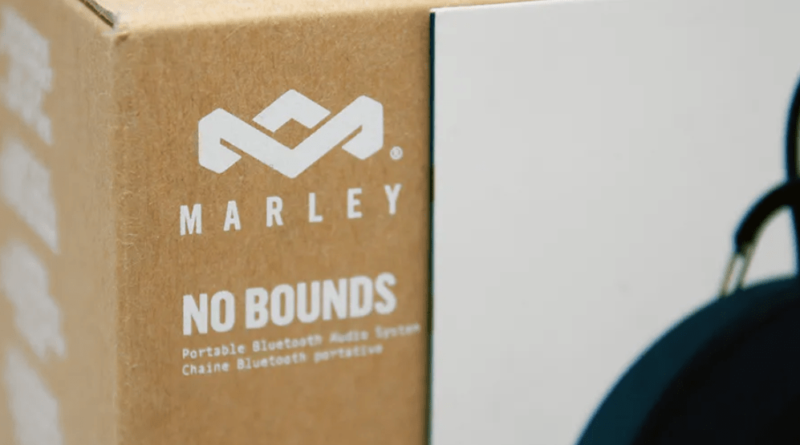
- Yuto (paper packaging)
YUTO Packaging Technology Co, also based in Shenzen, is a leading provider of high-end brand packaging solutions in China. Specializing in consumer electronics, health, tobacco, cosmetics, and food, this packaging manufacturer in China provides carton and paper packaging respecting the environment.
YUTO is indeed advocating green printing and the low-carbon recycling economy:
‘‘YUTO Tech takes the “green, environmental protection, low carbon” printing, and packaging as the future direction of enterprise development.’’
In recent years, YUTO Tech has won several rewards such as the “Top 100 Chinese printing and packaging enterprises in 2016 and 2017”, “China Excellent Packaging Brand,” “National Printing Demonstration Enterprises”,…
- Asia Pulp and Paper Group (pulp and paper packaging)
APP, founded by a Chinese Indonesian, sells different types of packaging including bleached hardwood paper pulp, a full range of paper, tissue, packaging, stationery products from commodity-grade base paper, tissue and industrial paper to value-added writing and printing paper, coated paper and boards.
It is one of the world’s leading paper manufacturers.
The company has also set aims to become more environmentally-friendly through its Sustainability Roadmap Vision 2020 to promote green packaging in China. This roadmap involves requires their main raw material, wood fiber, to come from sustainable sources. To do that, they have implemented better practices such as Chain of Custody systems, High Conservation Value Forest (HCVF) assessments and protection, and Sustainable Forest Management certification.
In April 2014, they introduced the Forest protection and restoration commitment to support the forest conservation and restoration of rainforest in Indonesia.
‘‘APP is committed to protecting biological diversity, particularly with regards to native plant species, Sumatran tigers, elephants, orangutans, birds, and other animals.’’
Packaging design in China: How Daxue can help you
As a competitive market research agency in China, Daxue Consulting can help you creating your packaging for the Chinese market. Our team is dedicated to giving you the best understanding of Chinese consumers and to assist you in each step of your packaging design process.
First, Daxue Consulting performa customized social media listening plan to analyze comments on Chinese social media such as Xiaohongshu, Weibo, Wechat as well as shopping platforms in China like Taobao, Tmall, JD.com, etc. This social listening phase will help you identify the best consumer insights from your current or potential buyers.
Then, this first raw data needs to be confirmed, and Daxue Consulting has provenexpertise in online surveys and focuse groups in China. Our research team can conduct a questionnaire and use the data collected to determine purchasing habits as well as storage practices towards your competitors. This is at this point that focus groups in China can be particularly interesting. It will allow you to see the strengths and weaknesses of the packaging currently available in the country, in terms of aesthetics and practicality. For an even more reliable and realistic result, we recommend combining focus groups in China with shop along to spotlight spontaneous reactions by observing the participants packaging journey.
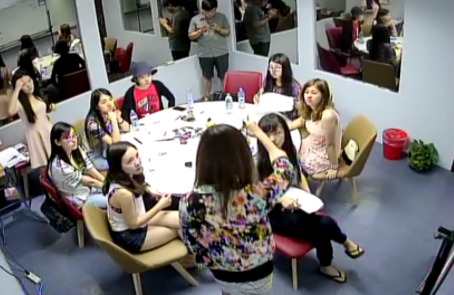
As the last step, Daxue’s team can conduct mystery e-shopping to test the ease of the shopping experience on your packaging design, from delivery to the intended usage to see how the packaging condition is evolving.
The national issue of over packaging in China
An ecological disaster that cannot be ignored anymore
One thing that may shock you when you arrive in China is the tons and tons of unnecessary packaging for certain products. This is what we can call ‘‘Over Packaging’’. It describes a product that is wrapped in several layers of plastic or paper, which are unnecessary or unwanted by the consumer. A common case in China is a small item wrapped in plastic, surrounded by an air cushion, placed in a small box and then placed in a bigger box for delivery.
This is not surprising considering that China has surpassed the United States and become the world’s leading market in terms of packaging. In 2022, China is expected to widen to 276 billion USD, making North America about three-quarters (approximately 78%) the size of China’s market by value.
However, despite the omnipresence of the trend of green packaging and zero waste in the West, China is a little behind on this subject, even if initiatives are taken. Over packaging in China is thus a major issue.
The environmental organization Greenpeace recently announced that less than 10% of packaging material in China gets recycled. The packaging industry in China is, therefore, a real scourge for the environment.
And there are several reasons for this.
First of all, the development of e-commerce. With the boom of E-commerce in China, the amount of packaging used for the transport of goods has dramatically increased, causing a devastating effect on the environment. Last year, Chinese people received nearly 1.9 billion packages within 10 days of November 11. It means about 1.4 for every person in China!

In 2018, the Chinese received more and more parcels. In February 2019, consumers received more than 3 times as many packages as in February 2018.
Then, food delivery apps in China create tons of waste every day due to plastic containers, bags, and utensils that come with each order. Food delivery apps in China have an estimated 355 million users, meaning that a quarter of all Chinese people are ordering food from their phones. For example, there are more than 1.8 million food delivery orders placed every day in Beijing alone.
Finally, the Chinese food industry also contributes negatively to the environment, with the increase of packaging in fruits and other fresh produces. Here are common examples:
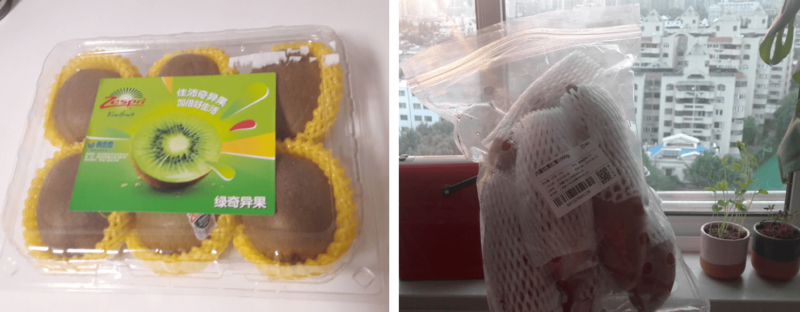
New green Chinese standards and initiatives against over packaging in China
At the end of 2018, the Chinese government introduced new ecological standards to promote the use of green packaging in China and recyclable materials. These new standards are in line with China’s 13th five-year plan where the government agreed to improve environmental management and protection in several sectors such as emission controls, clean energy, etc.
This new positioning against over packaging in China is supported by the initiatives of e-commerce giants. Recently, Alibaba has pledged to make logistics greener, opening green warehouses. These new warehouses package parcels with renewable materials. They also try to implement a recycling program and have developed biodegradable plastic bags and reusable paper boxes that use glue instead of wrapping tape.
Alibaba’s rival, JD.com, is also working against over packaging in China. They have set up a program where consumers can return delivery boxes free of charge for reuse, up to 10 times.
On the delivery apps side, the battle has also begun. The famous Ele.me app has created an environmental laboratory in Shanghai called RELAB. The latest initiative of this lab was the operation ‘‘No Chopsticks’’, where consumers could choose to say no to chopsticks sent with their order. It has saved 43 million pairs of chopsticks, as of November 2018.
New young Chinese start-ups are also fighting against over packaging in China. This is the case of XHG (Xiao Huang Gou), which offers money on Wechat to consumers who sort their waste according to the weight of garbage recycled through their smart bins.
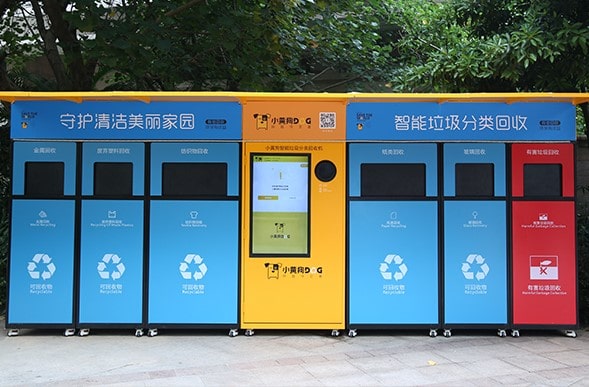
Some tips for adapting your packaging while avoiding over packaging in China
- Adopt Chinese codes
As presented in this article, it is necessary to understand the preferences of Chinese consumers in terms of packaging. You can search the related products on Taobao and look for the different kinds of packaging used by competitors to understand better how does packaging look like in your category. You also need to find the delicate balance between your Chinese and Western name on the packaging.
- Choose the right material
Choose a material that matches the values of your brand and product. Today it is easy to opt for green packaging in China. We can take the example of the tea brand SQZ, which has chosen a material that is both practical and environmentally friendly in its production process in China in 2019.
The brand has chosen to package with a low impact on the environment because it is very light and contains 35% chalk.
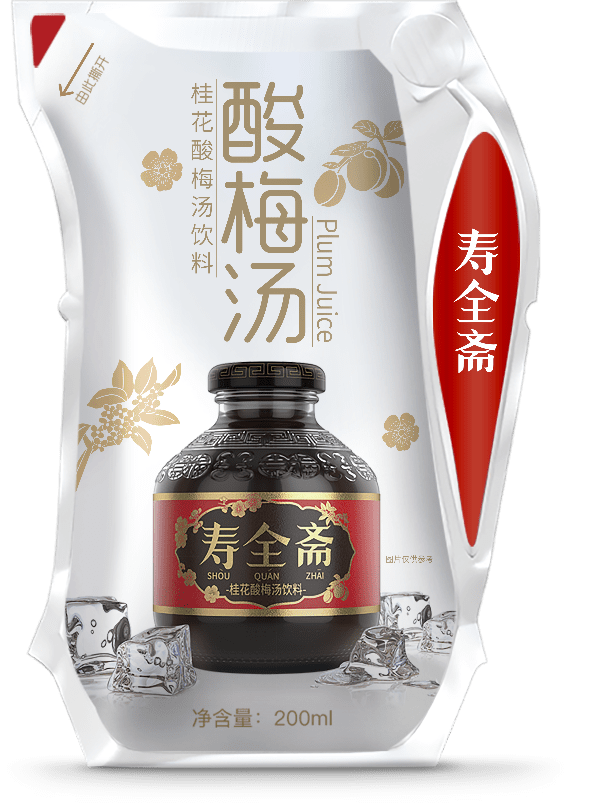
- Offer a “shareable” experience
One proof that the Chinese attach great importance to packaging is that they like to share their best finds on social networks. An excellent way to encourage this is to offer limited editions for Chinese festivities. This is what the foreign brands SK-II and Glam Glow have done during the 2019 Chinese New Year by offering beautiful packaging celebrating Chinese culture:

Need help creating your packaging in China? Contact us now to discuss your project. Our experienced and international team is dedicated to giving you the best advice and insights on your consumers in China and their packaging preferences in 2019.
Author: Steffi Noël



